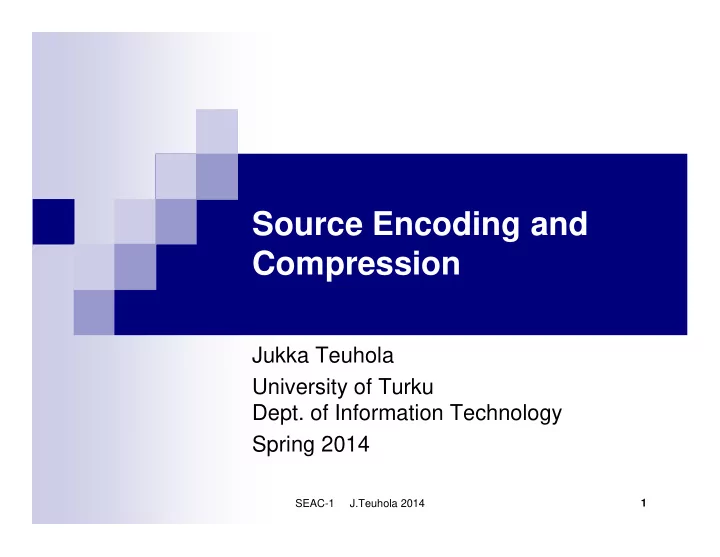

Source Encoding and Compression Jukka Teuhola University of Turku Dept. of Information Technology Spring 2014 SEAC-1 J.Teuhola 2014 1
General � Self-study course, starting lecture: 14.1.2014 � Extent: 5 sp (3 cu) � Level: Advanced � Preliminary knowledge: Data structures and algorithms I, basics of probability calculus � Material: Lecture notes and Powerpoint slides available via the course homepage. No textbook is needed. � Homework: 10 small exercise tasks will be given. Solutions must be submitted to the lecturer before taking the examination. Minimum: 5 solutions acceptably solved. � Examinations: Three attempts; March, April, May 2014 SEAC-1 J.Teuhola 2014 2
Optional literature � T. C. Bell, J. G. Cleary, I. H. Witten: Text Compression , 1990. � R. W. Hamming: Coding and Information Theory , 2nd ed., Prentice-Hall, 1986. � K. Sayood: Introduction to Data Compression , 3rd ed., Morgan Kaufmann, 2006. � K. Sayood: Lossless Compression Handbook , Academic Press, 2003. � I. H. Witten, A. Moffat, T. C. Bell: Managing Gigabytes : compressing and indexing documents and images, Morgan Kaufmann, 1999. � Miscellaneous articles SEAC-1 J.Teuhola 2014 3
Contents 1. Basic concepts 2. Coding-theoretic foundations 3. Information-theoretic foundations 4. Basic source coding methods 5. Predictive models for text compression 6. Dictionary models for text compression 7. Compression of digital images SEAC-1 J.Teuhola 2014 4
1. Basic concepts Data compression: � � Minimize the size of information representation. � Reduce the redundancy of the original representation. Purposes: � � Save storage space. � Reduce transmission time. Basic approaches: � � Lossless compression: decompression into exactly the original form (typical for text). � Lossy compression: decompression into approximately the original form (typical for signals and images). SEAC-1 J.Teuhola 2014 5
Basic concepts (cont.) � Fields of coding theory: � Source coding : purpose to minimize the size � Channel coding : detection and correction of transmission errors. Model Model Errors Source Channel Channel Source Source Sink encoding encoding decoding decoding Communication channel � Also: cryptography : Encryption of private/secret information SEAC-1 J.Teuhola 2014 6
Basic concepts (cont.) � Phases of data compression: � Modelling of the source � Source encoding (called also entropy coding ), using the model � Other viewpoints: � Speed of compression / decompression � Size of the model � Classification by lengths of coding units: � Fixed-to-fixed coding � Variable-to-fixed coding � Fixed-to-variable coding � Variable-to-variable coding SEAC-1 J.Teuhola 2014 7
Examples of models 1. Character 2. Successor 3. Dictionary distribution distribution Char Prob Char Succ Prob Word Prob A 0.10 A A 0.01 ALL 0.02 B 0.05 A B 0.20 ALWAYS 0.01 C 0.08 A C 0.10 ARE 0.05 D 0.06 A D 0.25 AS 0.03 E 0.15 ….. ….. …… AT 0.02 ….. ….. B A 0.15 BASIC 0.01 B B 0.02 BEGIN 0.01 B C 0.01 ….. ….. B D 0.01 ….. ….. ….. SEAC-1 J.Teuhola 2014 8
Basic concepts (cont.) � Main classes of text compression methods: � Dictionary methods � Statistical methods � Classification based on availability of the source: � Off-line methods � On-line methods � Classification based on the status of the model: � Static methods � Semiadaptive methods � Adaptive methods � Measurement of compression efficiency: � Compression ratio: Source size / compressed size � Bits per source symbol (character, pixel, etc.) SEAC-1 J.Teuhola 2014 9
Illustration of a static method Background knowledge of the source data types Model Model Derived once Use Use Decoded Source Encoder Decoder message message Send Write Read SEAC-1 J.Teuhola 2014 10
Illustration of a semiadaptive method 1. Build Model Model 3. Send Source Use 5. Use message Decoded 2. Read Encoder Decoder message 4. Send 6. Write SEAC-1 J.Teuhola 2014 11
Illustration of an adaptive method Models are updated dynamically, based on the already processed part of the source, known to both encoder and decoder. Initial model fixed Initial model fixed Processed Processed Model Model part part Dynamic Dynamic Use Use update update Source Decoded Encoder Decoder message message Send Read Write SEAC-1 J.Teuhola 2014 12
Recommend
More recommend